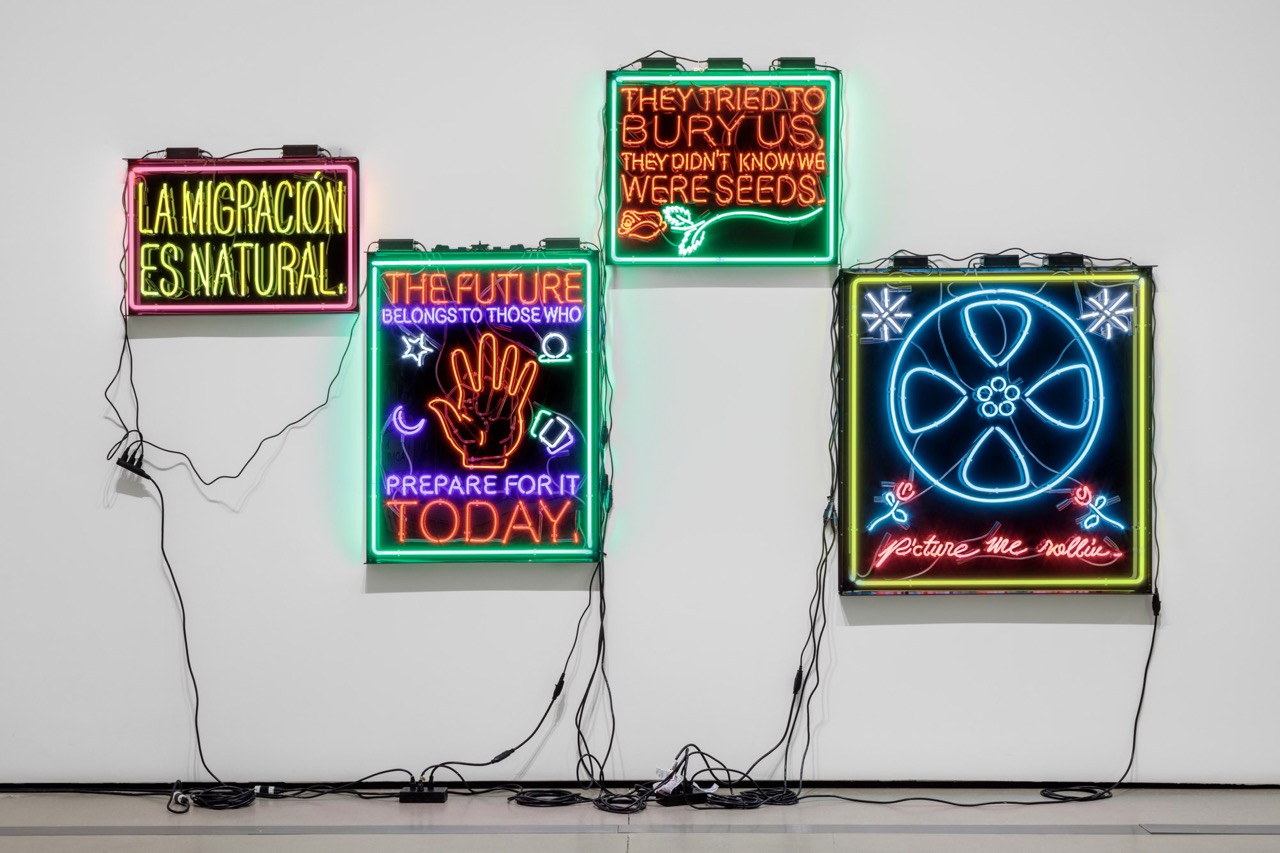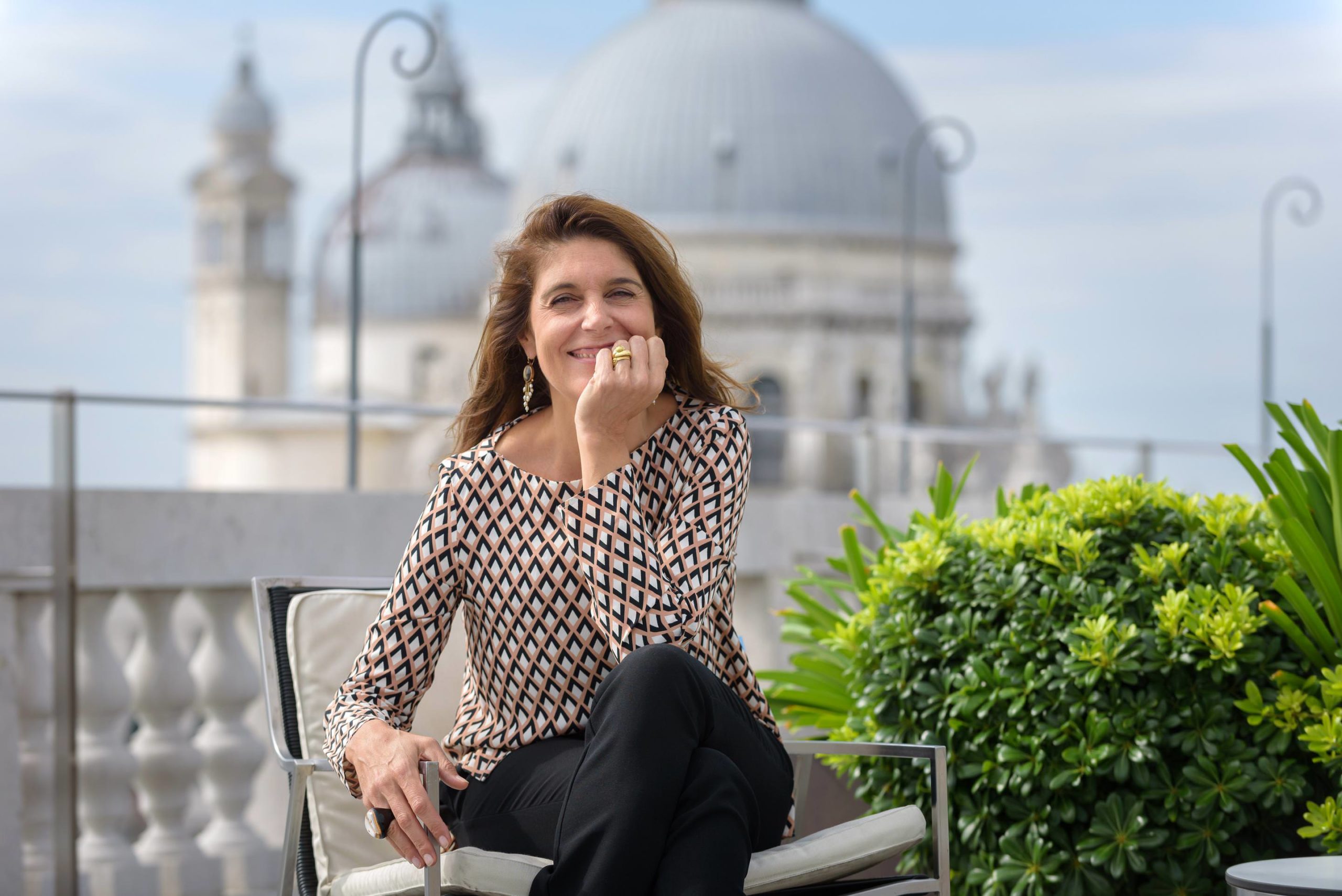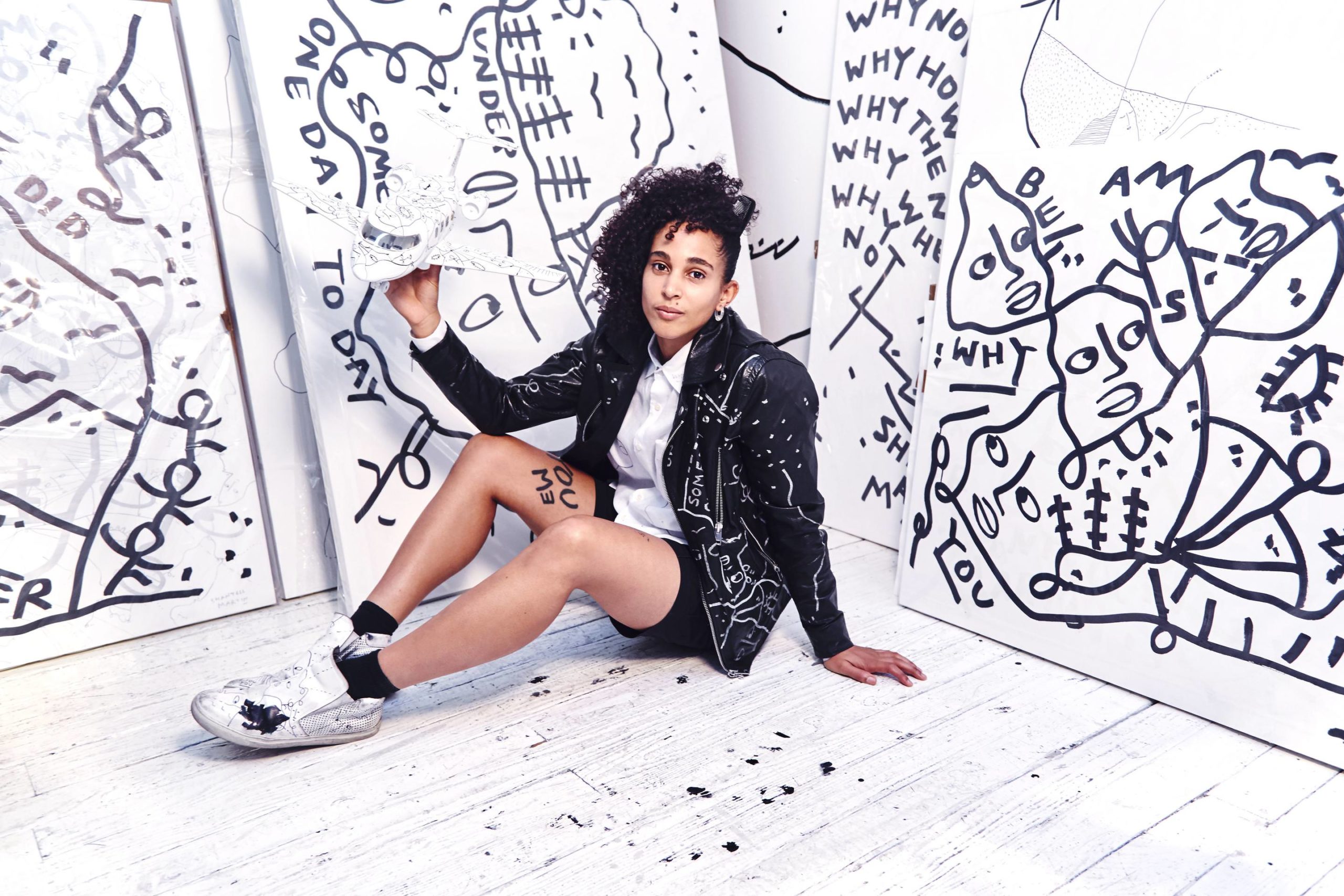“I’m very drape-y,” says artist Mark Bradford as he dangles his limbs over the back of a chair. The photographer wants to know if he was ever a dancer. A smirk passes across Bradford’s face. “Giiiirl,” he says.
That Bradford spent his youth in nightclubs—before embarking on a career that would lead him to become one of the most prominent Los Angeles artists on the international scene—is common knowledge by now. And everyone knows about him coming of age in his mom’s salt-of-the-earth salon and finding his earliest materials there.
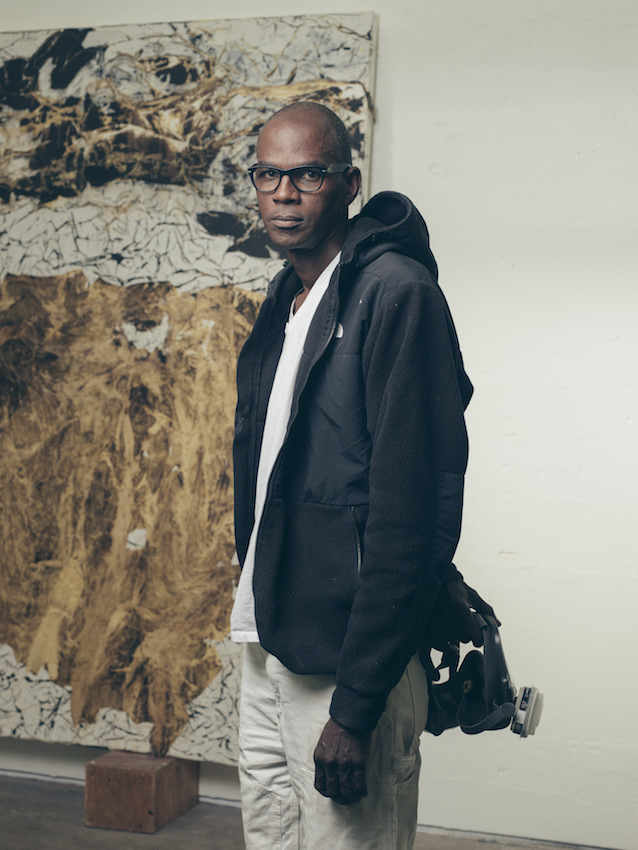
Photo by Sebastien Micke.
That’s all well-trod territory. In fact, to focus too much on the artist’s identity clouds the fact that Bradford is still coming down from “Scorched Earth,” a survey at the Hammer Museum that was zealously received, due in part to Bradford’s ability to bring much-needed political concerns into his handcrafted abstract process of assemblage and painting.
Whitewall caught up with Bradford as he was preparing a solo exhibition at the Contemporary Art Museum St. Louis (which closed August 14); a show at the Albright-Knox Art Gallery in Buffalo that pairs his work against Ab-Ex practitioner Clyfford Still’s striking paintings (on view through October 2); and a massive site-specific painting at the Smithsonian’s Hirshhorn Museum and Sculpture Garden (to be unveiled November 17). On top of all that, Bradford was recently selected to be the U.S. representative for the 57th Venice Biennale, opening May 2017, for which he will create a site-specific work.
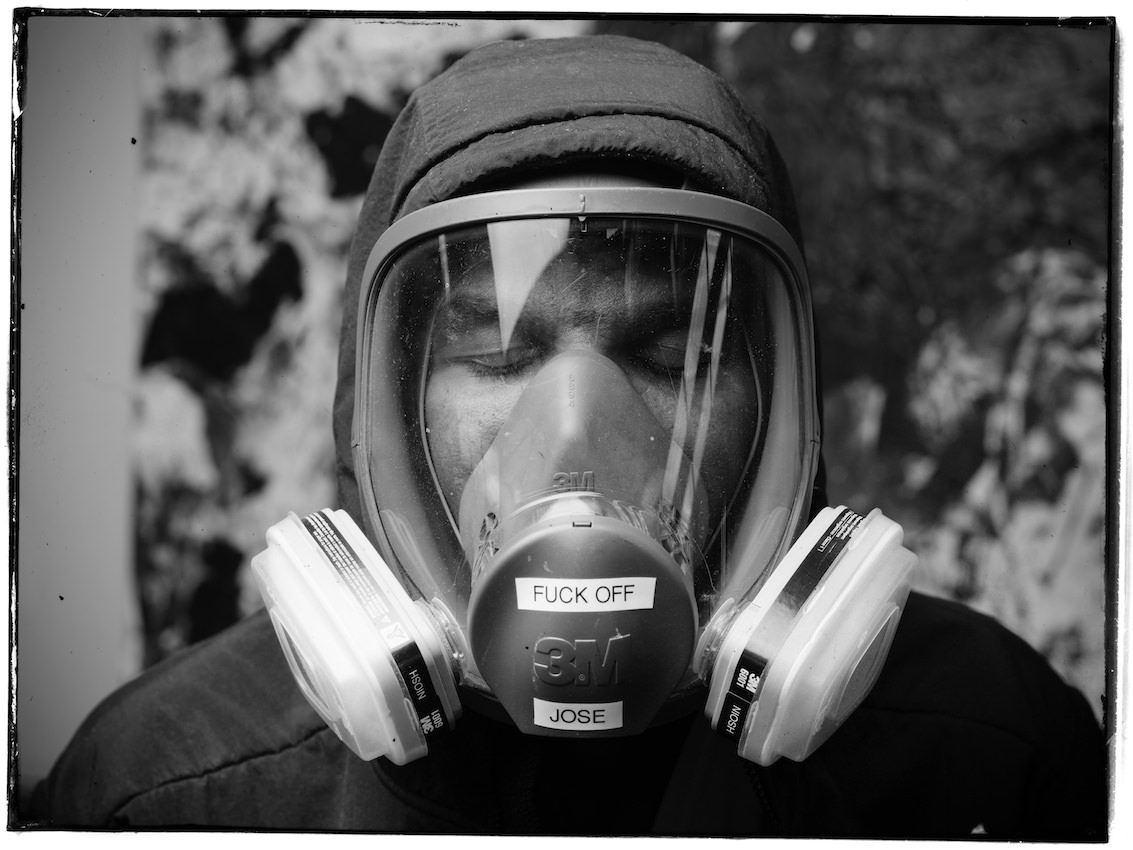
Photo by Sebastien Micke.
WHITEWALL: What’s happening in your studio with the Hirshhorn exhibition?
MARK BRADFORD: The whole idea is about Myrlie Evers. When they asked me to do a show at the Hirshhorn, I instantly went to Civil Rights, the Mall, “We Shall Overcome.” Investigating the program [for the March on Washington on March 28, 1963], I realized that women were very much excluded. I started thinking about Civil Rights and how there was still a white male–black male conversation. That started with me looking for a margin within a margin. I realized that Medgar Evers’s widow did not give her speech that day. [It was on the program], but they did not make it accessible for her to get to the stage. And they historicized it in a very different way.
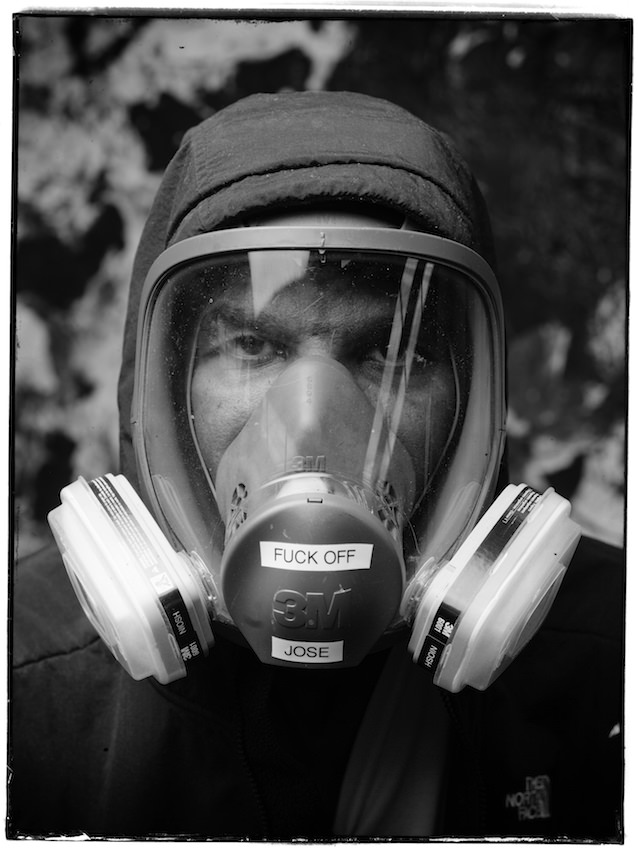
Photo by Sebastien Micke.
WW: What’s the prevailing narrative?
MB: Some of the narrative is that she missed the plane. I’ve read a few accounts, and they never add up. I was able to contact Mrs. Evers, and she came to the studio and we had some really long, great conversations about how she wanted to work with us. We don’t know exactly what the shape of that’s going to be yet, but we know that we’re probably going to use some of that conversation.
Then I started thinking about Bayard Rustin, an amazing Civil Rights activist who mentored Martin Luther King, Jr. He was gay and was not allowed to march. Again, I became fascinated by the story within the story. I’ve also been working with Anita Hill, and she’s been interested in showing me other women’s voices that were happening that day. Women were really instrumental in organizing that march, but oftentimes in the retelling of things—just like they were complaining about Straight Outta Compton—where were the women? They always get marginalized.
WW: You went to CalArts at 30, a bit of an older age. Prior to that you were involved in the nightclub scene in Europe. What made you choose CalArts?
MB: I went because they gave me a scholarship, initially. I stayed because it was really a theory-driven school, and since I was such a material person, I found that I let my hands do the talking for me. At CalArts, I learned how to use language to support my ideas. For every artist, that’s super-important. A lot of artists can make, but sometimes you can’t talk about your work. Oftentimes, artists tend to be shy—usually from early societal, communal, family bullying. Because if you’re a little weird, you learn to stay silent. When you’re an artist, they tell you, “Speak, child,” and you’re like, “Uh, I don’t really do that.” I had to learn how to not be afraid, because fear is a huge thing when you’re different. You get that memo real early. At CalArts, they make you think. And that was a really hard thing for me, because I was more of a doer, a hustler—making it happen. [Snaps fingers dramatically]
WW: I’ve been interested in how Ed Moses influenced you, and how Laddie John Dill mentored you. What did these two older L.A. artists mean to you?
MB: Laddie John Dill and Ed Moses were old-school post-Ab-Ex artists who believed in a studio practice: Show up every day, and let the material do the talking. I went to the Santa Monica College of Design, Art, and Architecture, which was a private school. They gave you a studio for two years. I got in that school straight out of Europe, straight off the nightclub dance floor, and I started putting material together, and my teachers said to me, “You have something.” I was like, “Really? What’s the big deal? I just do it.”
Before this, I was a bad student; I went to a “continuation high school” with the bad girls who smoked cigarettes. This was the first time I could do something comfortably, and I could do it every day. The only thing I could do from ages 14 to 28 every day was nightclub. I thought I would just be in the nightclubs every day for the rest of my life. To me, life has a lot to do with what you do every day, and when you’re an artist, what you do every day is really who you are.
WW: I wanted to talk about Crow [2003/2009]. You’ve talked about the crow as being the symbol of death, not just about it being the symbol of Jim Crow. How did you become interested in talismans?
MB: AIDS. I didn’t know anything about talismans or death or crows, but then came the AIDS epidemic in 1981. I was 18. I saw death in everything. You walk under a ladder: “Oh, shit! That’s death.” I’m black—in case you didn’t know—and the church made it biblical. God’s wrath. Everybody got sarcomas. Looking for metaphors about death started when I was 18 or 19.
WW: Do you still work with death?
MB: Not as much. I think I work more with life. I work with foster kids. And that’s the opposite of death. I’ve been through the valley.
WW: Tell me about working with foster kids, and how that turned into Art + Practice.
MB: My partner Allan [DiCastro] comes from an activist background, and he has always been in city politics and working with communities. I watched him do that, and thought, “Well, that’s amazing.” About three or four years ago, we realized that we had some real estate we didn’t know what to do with, and we thought, “What about those two ideas: art and practice? Or art and social activism? Put them together.” In doing research, we looked at women’s shelters. We looked at the 90008 area and discovered that there was a high percentage of foster youth at Crenshaw High School and the middle school, Audubon.
I feel like artists sometimes are outsiders, and I feel like foster youth, through no volition of their own, are born outside of the social contract. Being an artist, I could relate to how you have to navigate sometimes without a net, and how nobody cares, especially if you’re an unsuccessful artist. So that became our framework for a nonprofit. The Hammer said, “Mark, we’re really interested in helping program the first couple of years.” It was not to do anything other than create a sustainable economic educational platform for foster youth, and to expose the local community to contemporary ideas. I had no idea it was going to be as big as it was.
WW: And the first exhibition was with Charles Gaines at the same time as his Hammer survey.
MB: Here’s what I thought about it: “Why not have the first show be a Conceptual artist who is black, that completely abstracts the stereotype paradigm of what black art should look like?” You’re in an all-black neighborhood that has maybe never had a relationship to Conceptual art. To many people in the local community, the first exposure they had to contemporary art was a black Conceptual artist, Charles Gaines. That means that the possibilities open up and become vastly infinite. Amazing.
WW: I’m flying internationally on Friday, which means I’m going to be passing through the Tom Bradley Terminal, which means I’m going to be going under the Bell Tower, which you’ve said is a sort of Jumbotron made from wood sourced in urban areas.
MB: The old Bell Tower, built in a shantytown.
WW: I was wondering about these public pieces in these hyper-aware spaces. It’s quite a serious message for travelers. Is that the piece that you get the most feedback about, and has it changed for you at all since it went up a few years ago?
MB: Most people around the world understand what that is. They’re like, “Well, I don’t think it should be art, but I know what it is. That’s that stuff around the city.” I wanted international urban decay, and I wanted to build it out of wood; I wanted it to reference information and time. It’s dead technology: paper’s running out. We’re all on a tablet. It does everything that I wanted it to do. I wanted to do a piece of serious sculpture in the public. I didn’t want to do “public art.” I’m always uncomfortable when I see it, though.
WW: I saw a talk with you and Thelma Golden, and something I thought was interesting was you said, “I don’t believe the rhetoric around abstract painting,” which I took to mean as you simplify interpretation of your work as a way of approaching it. Do you see that that way?
MB: Yeah, I don’t believe the rhetoric around this hermetic, internalized force that works through you that you have to block out the world, and it has to be apolitical, and a painting is a painting. I don’t believe that. How is that possible? I think that probably it’s been constructed that way. I don’t know if the Ab-Ex artists were political or nonpolitical. I wasn’t there. I know Clement Greenberg had a position. And then Rosalind Krauss deconstructed that, and then painting was dead. I’ll tell you one artist that I always liked: Asger Jorn. I spent time looking at his work in Europe when I lived there. And he had no problem connecting art and political, art and the society, art and the world.
By the time I got back to the U.S., I thought, “Of course. It’s all part of the same narrative.” So, I never had this split. But then I never had the Frantz Fanon split with the white skin/black mask. I never had the double-speak. I never had any of the dilemmas of navigating between different spaces. I think that we demand that people have a dilemma—say, a woman having a dilemma with being a mother and a feminist. Or my mom had a hair salon in all-black Los Angeles, and I lived in all-white Santa Monica. There should be a dilemma there, and there never was a dilemma.
So if I didn’t have a dilemma, I wasn’t going to make one. I’ve had my own dilemmas, but it certainly wasn’t around some logical stereotype. So I just never believed the rhetoric. I thought, “My world will have relevance, and be contemporary, and have the language of its time, and I’ll use the information that I want, and I’ll just go forward.”
WW: But there was never any friction in doing that?
MB: Other people have lots of friction with what I do. It bothers them more than it bothers me. We’re constantly reevaluating history. The Constitution of the United States has amendments. So I thought, “Abstract Expressionism, being one of the biggest movements that influenced the world to this very day, is this thing that has been left at hallowed ground. Well, why?” You could deconstruct it as being bad, and all white men. I’m not white, so I thought, “What does that have to do with me? I’m not carrying that dilemma.” And then I thought, “Surely there were practitioners who were black,” and I started to read about Jack Whitten and Norman Lewis and Frank Bowling, and all these great people who were carrying on completely out of the spotlight. I thought, “What about Alfred Barr, MoMA, the start of that whole thing?”
So I don’t know what the word “Abstract Expressionism” means. I don’t even consider myself that, because I’m an abstract painter but I don’t use paint, so what does that mean? Abstraction is a conceptual framework that I can interrogate ideas, and move them around, and demand a new view.
WW: But in a way, just by doing it, there is a certain politic to it. Just by being a black body that is making abstract art.
MB: Absolutely. It is, in and of itself, political. The most political thing I could do was to be black and in South Central and do abstract painting. To deconstruct the narrative around figuration and realness in regard to the black body, which is so heavily over-determined. It’s such heavy baggage on me, that it’s like, “How can I find new ways into me if I’m constantly giving you the body? Can’t we be allowed to just be playful and goofy? Oh, that belongs to the white male body, to be goofy.” But it’s great, because it is starting to change. You see characters on television who are black and goofy, black and awkward.
WW: One of the pieces that I spent the most time with at the Hammer was the video of the stand-up routine, Spiderman [2015]. It has its roots in entertainment, but is very raw. How did you come to stand-up as a part of your practice?
MB: There are few paradigms that black males who live in Hollywood are allowed to be: One is the buffoon. We have this long comedic tradition, so I wanted to step into that. I also found that it can be brutal and polarizing, especially to women and gay people. I remember Eddie Murphy’s Delirious, and the first time I heard him say “faggot,” and the crowd was roaring, which meant that it had societal approval. And so I wanted to create a character that turned it in on itself. It was the antihero to Straight Outta Compton, and to Delirious.
I sat in my chair in the studio, and I just think of all this stuff. Of course, he would have to be trans, because it would’ve had to have come from someone who had had enough, and was going to actually reinvent herself. And then I just went for the stuff that I wanted to talk about: this unfairness with the way that we treated Eazy-E having HIV, and the way that we treated “sissy” Gerald. [Acting out his joke from Spiderman:] “Sissy Gerald—two fingers up his ass with the birth control—” I terrorized my studio, walking around with a microphone.
Rage is not far from comedy, and so I find when I put the comedic gaze on, rage comes. Rage at things that hurt me, or rage at things that I thought were unfair. Sometimes comedy can be very mean. I really don’t like comedy, actually. I found it was very easy once I stepped into character. I probably have a whole album in me. I found it was very easy to go and turn against the patriarchal black male. I felt very bell hooks.
WW: I wanted to ask about being on the board of the Museum of Contemporary Art, Los Angeles. Why did you accept that designation?
MB: I have no idea. I’m still learning. I think it’s very important to have artists on the board of institutions that are supported by and are for artists. It’s just another perspective looking at the same idea. I think that’s always helpful. They have politicians that sit on the board, they have philanthropists, heads of state, billionaires—if it’s about artists, it’s good to have some on the board, right?
WW: Definitely. Tell me a little about the Clyfford Still show. How did you become so enmeshed in his work?
MB: I was fascinated by all these Ab-Ex manifestos. Clyfford was the manifesto dude: how his work was shown, how it couldn’t be shown. I liked him, because de Kooning was much more elegant, and Pollock was Pollock, but Clyfford was rougher. His work wasn’t as pretty.
I’m fascinated by his insistence on using the color black. What does the color mean? Is it possible for a black artist to use the color black and for it to not be political? Probably not. Because in the way in which the narrative of this country is constructed, race and identity are [smacks his hands together] like that. So, if I’m black, and I wear black for a whole year, it must mean something different than that I like the color black. I put propositions on the table. I don’t have answers for it. I put myself at the middle of the quandary.
WW: You’re showing “Receive Calls on Your Cell Phone from Jail” at the Contemporary Art Museum in St. Louis. There’s a lot to think about when you mount a show there, particularly a show about the prison complex.
MB: It’s tense. That’s why I wanted to show there. I don’t know if I want to have a conversation with St. Louis per se. This is a national conversation that we should be having. We have to talk about the police state, and what that means, and we have to talk about the fact that all bodies are not viewed the same within the political narrative. We have to agree upon that. And so the whole show came out of the disproportionate number of black men in jail. There was a merchant poster that addressed the fact that you can’t make calls to cell phones from jail, and I just used that as a template and built a show out of it.
This article is published in Whitewall’s summer 2016 Design Issue.




